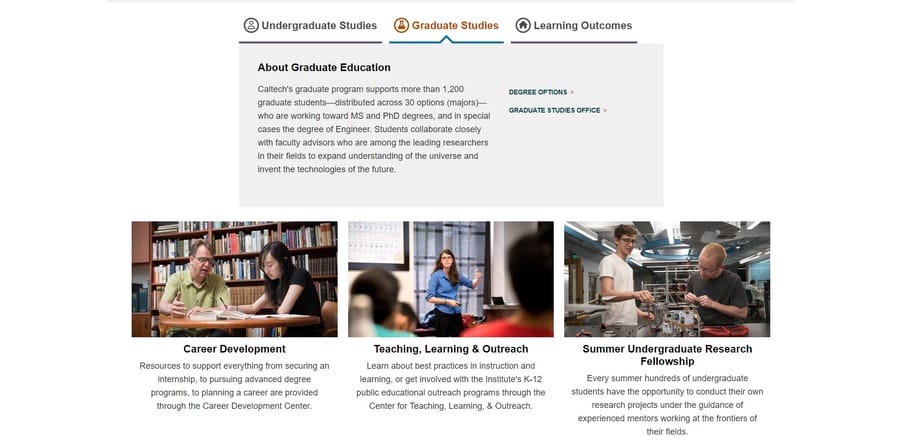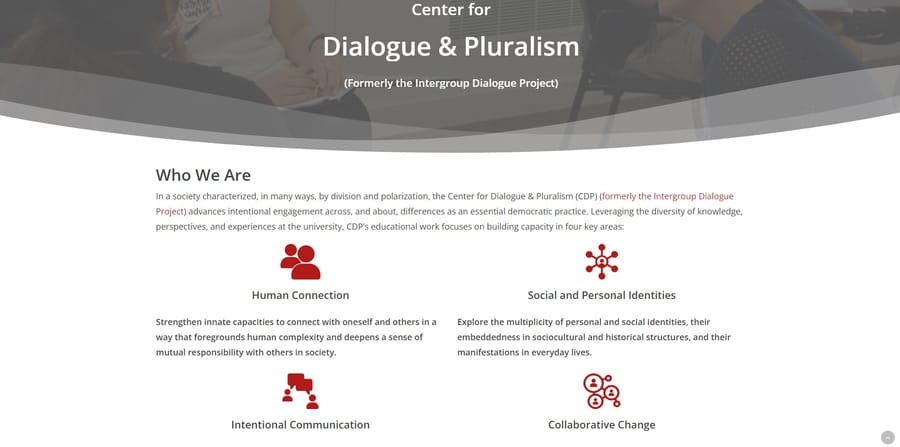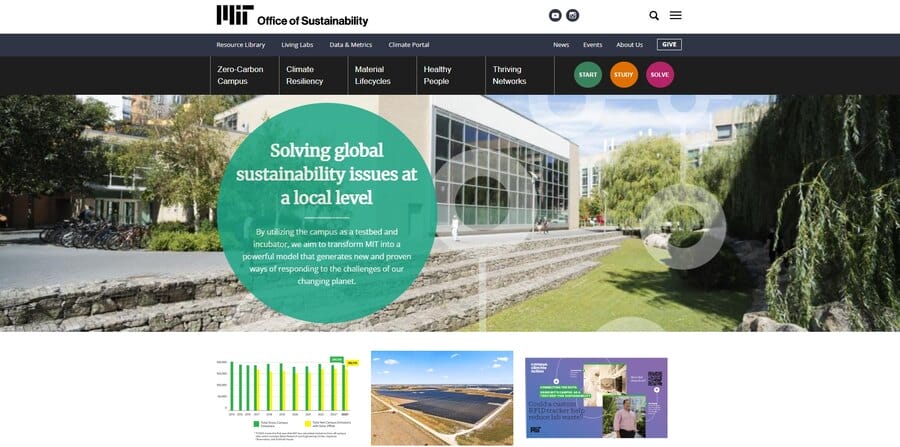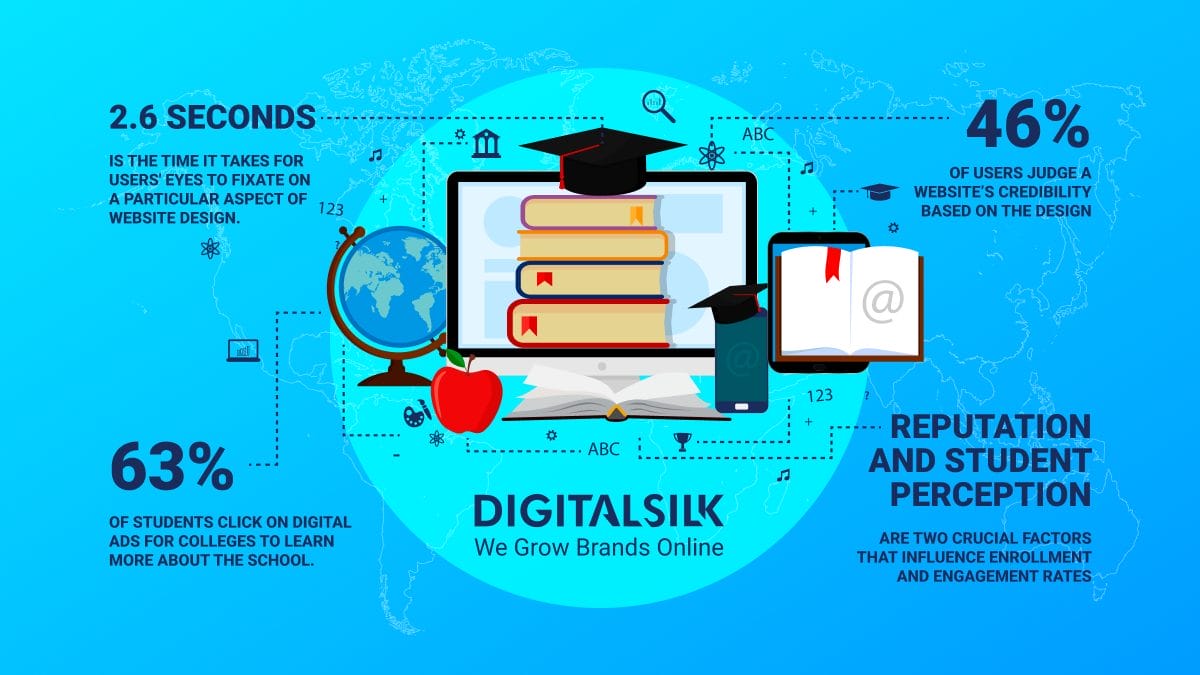In 2025, the race for fresh enrollments has never felt more intense.
As part of a digital-first society, academic institutions should build a reputation that extends beyond a memorable tagline and becomes a part of a constant conversation on social platforms, in student forums and across international networks.
By the 2031/2032 academic year, there will be 4.83 million higher education degrees earned in the U.S., a statistic that underscores the growing scale and complexity of the education landscape.
This guide uncovers 10 actionable university branding guidelines to help your institution carve out its distinct story in a competitive field.
How To Build A University Branding Strategy
54% of students research their preferred program online.
Your university branding campaign reveals character, sparks loyalty and shapes how prospective students, alumni and donors see the institution.
Below, we share insights into fresh methods for online engagement, steps for nurturing real community connections and tips for sharpening your messaging to resonate with your target market.
1. Define Clear Brand Identity And Value Proposition
Your brand identity and Unique Value Proposition (UVP) reflect your core promise to shape how prospective students see your institution before they even set foot on campus.
These guidelines cover the institution’s mission, core strengths, community ethos and forward-looking goals to build trust and connect emotionally with prospective students.
Consider your target market’s values, concerns and aspirations by answering a few key questions:
- What challenges do they face?
- What kind of campus life and career support do they need?
- How can your university help them achieve their goals?
This way, you compare your university’s strengths with students’ needs and present your offer through a valuable, engaging and memorable brand experience.
For example, Harvard University is known for its challenging academic programs and a culture that prizes deep inquiry and thoughtful debate.
Students are drawn to the institution not only for its storied past but also for its promise of shaping future leaders and redefining the boundaries of knowledge.
2. Create Consistent Messaging And Visual Identity
55% of first impressions are based on your visual brand language.
When every touchpoint and channel — including websites, social media platforms or printed brochures — reflect the same tone and design elements, students can connect with and recognize your institution much easier.
This consistency clarifies the institution’s mission and values and helps distinguish its signature position in a competitive higher education market.
To achieve this, you should outline a detailed brand book that includes the following elements:
- Determine brand voice and messaging requirements
- Define brand colors, fonts and imagery style guide
- Create a signature and memorable logo
- Develop mockups of collaterals with consistent design elements
- Establish guidelines for different channels and mediums
Take the University of California, Los Angeles (UCLA) as an example — the institution uses its signature blue and yellow colors in all branding materials, from its website to its social media pages and even its merchandise.
Its friendly, approachable and student-centric messaging is also evident across all platforms, which increases brand preference and drives enrollment.
3. Highlight Signature Programs And Resources
Emphasizing your institution’s unique strengths helps create an identity beyond rankings or location.
It lets prospective students imagine themselves thriving within your ecosystem, growing through signature programs and being supported by vibrant student communities.
Instead of simply listing programs and resources, you should build a narrative that connects innovative research, specialized programs and comprehensive student experiences.
You can do this by:
- Emphasizing niche or distinguished programs to build positive associations
- Spotlighting research centers, innovative projects and partnerships
- Promoting student support services and extracurricular activities
- Showcasing student achievements and success stories
This way, you connect your brand with tangible outcomes to show students that your establishment is capable of nurturing, supporting and guiding their development.
For example, Caltech clearly outlines specialized STEM programs, career development opportunities and tangible learning outcomes to demonstrate its academic prestige and student-focused approach.

4. Use Social Media For Brand Awareness
51% of Gen Z turn to social media to research a particular brand.
As younger generations rely heavily on social channels for information and entertainment, these platforms can be your ticket to nurturing real-time engagement, highlighting achievements, showcasing campus life and participating in viral trends or challenges.
This approach also allows you to promptly address student queries, present actionable solutions and build meaningful relationships with existing students and potential applicants.
Yale focuses its social media strategy on showcasing its diverse and inclusive campus culture, building awareness through community-centric practices and promoting various resources for academic support and personal development.
5. Build A Community Based On Shared Values
For most students, starting university is a life-changing and somewhat intimidating experience.
Your university branding strategy should ease that transition by building a community based on your core principles to inspire collaboration, trust and personal growth.
When the values of the institution align with the personal beliefs of its students, it creates an environment where voices are heard and efforts are supported.
Students surrounded by like-minded peers and supportive professors develop stronger networks, participate in academic engagement and support community involvement.
Creating a university branding strategy that centers around shared values has the following benefits:
- Strengthens community bonds: Students who feel they are part of something bigger often grow into the most vocal brand supporters. They bring energy to campus events, recruit friends to join and stay connected after graduation.
- Shifts student perception: Only 36% of Americans show “quite a lot” or “a great deal” of confidence in higher education. Students tend to distrust overly polished statements, so let your values-based and community-led branding strategy speak for itself.
- Appeals to authenticity: 88% of users say authenticity is a deciding factor for which brands they support or endorse. Highlighting community values lets you speak to students as peers, not as a mass-produced commodity.
For instance, Duke University promotes academic collaboration, community engagement and like-mindedness through its “This Is Duke” campaign.
Moreover, you can create a signature mascot or persona to represent your institution and reinforce your university’s team spirit.
You can use this mascot in various marketing materials, such as posters, banners and social media graphics to improve brand recognition and recall.
For instance, Cornell University’s Big Red Bear is heavily featured in its promotional materials and merchandise to showcase its school pride and strengthen its brand identity.
6. Incorporate Diversity, Equity And Inclusion Practices
16 million students enrolled in the undergraduate programs in the fall of 2024.
Among them, there are people from various cultural, socioeconomic and personal backgrounds, all with unique perspectives, experiences and expectations.
But they all share a common goal — to receive quality education, create opportunities and build a better future for themselves.
This impressive figure reminds us that universities have the privilege and responsibility to promote diversity, equity and inclusion (DEI) within their campuses.
This is more than just a branding trend — it’s a proactive, ethical and necessary step towards creating a welcoming and inclusive environment for all students.
Here are some ways universities can incorporate DEI practices in their branding strategy:
- Create inclusive messaging to accurately represent all communities
- Showcase DEI initiatives like scholarships, support programs and diversity events
- Partner with diverse student organizations and highlight their voices and contributions
- Offer cultural competency training for faculty, staff and students for mutual respect
- Promote a diverse faculty and staff recruitment process to reflect the student body
- Provide helpful resources for students from underrepresented backgrounds
Cornell University takes a stance on DEI with its “Center for Dialogue and Pluralism” program, which aims to foster a culture of open-mindedness, respect and understanding among all members of the Cornell community.

7. Share Alumni Testimonials And Success Stories
Students want to know what’s on the other side of their university experience.
Transparent alumni narratives provide tangible success stories and a sense of authenticity that glossy brochures and formal mission statements simply can’t match.
These real-world stories humanize higher education institutions and turn faceless statistics into relatable journeys.
When past students talk about new ventures, career milestones or impactful community roles, it underscores the true worth of your university’s degree.
Some of the best university branding strategies to showcase alumni success include:
- Featuring alumni profiles on the university website and social media channels
- Hosting networking events for current students to connect with successful alumni
- Creating a dedicated alumni magazine or newsletter to share updates
- Partnering with alumni to offer mentorship programs for current students
Stanford University has a dedicated alumni section on its website to highlight the accomplishments of its graduates and showcase their diverse career paths.
8. Showcase Social And Environmental Involvement
73% of the general population believes brands should act for the good of society and the planet.
In a time when students and their families care deeply about community involvement and sustainability, your university should demonstrate a genuine commitment to making a difference.
This approach to branding goes beyond traditional marketing — it reflects a cultural shift in higher education through proactive strategies like reducing your environmental footprint and supporting social justice initiatives.
MIT’s very own Sustainability Initiative focuses on interdisciplinary research and education to address global environmental challenges.
The university acts as a testbed and incubator for cutting-edge sustainability solutions and transformative educational programs.

9. Host Thought Leadership Events And Conferences
You should use your university branding guidelines to demonstrate thought leadership, establish authority and improve positioning in the higher education sector.
Hosting or attending industry conferences, seminars and webinars offers a platform for sharing ideas, sparking debate and shaping public discourse.
Universities that choose this route are often seen as trailblazers in their fields and contributors to important conversations.
This approach can highlight your commitment to research, community engagement and the ongoing exchange of ideas.
This can also motivate students to pursue research, network effectively and take part in workshops that expand their educational horizons.
For example, Princeton has a separate section on its website dedicated to planning, organizing and promoting events that promote thought leadership, creativity, diversity and academic excellence.

10. Partner With Industry Organizations And Influencers
One of the most impactful ways to boost brand awareness and drive student engagement is to collaborate with high-profile organizations and respected voices in relevant fields.
Students want more than a degree — they want clear pathways to careers, mentorships and projects that matter.
When universities work with industry leaders or prominent influencers, they act as catalysts for cross-sector innovation and ongoing cooperation.
This can lead to exciting opportunities for students, such as internships, networking events and real-world projects that connect them with industry professionals.
For example, Bill Gates was part of the NAU Commencement Address for Northern Arizona University in 2023, where he shared his insights on technology, philanthropy and leadership.
Creating A Cohesive Brand Architecture For Multi-Campus Institutions
If your university oversees multiple campuses or includes several schools and faculties, maintaining a consistent brand identity across all locations can be challenging.
Each site may have different student demographics, cultures or signature programs that influence your messaging.
Some of the key tactics to create a unified branding strategy include:
- Centralized brand guidelines: Develop a master brand style guide that outlines key elements like logo variations, color palettes, typography and messaging principles.
- Implement local adaptations: While the overarching brand identity should stay the same, allow each campus to reflect its character with small modifications like a secondary logo mockup or campus-specific marketing materials.
- Prioritize faculty and staff engagement: Host regular brand training sessions so each department understands how to align its messaging with the central university identity. This fosters buy-in and prevents ad-hoc visuals or inconsistent language.
- Share stories across platforms: Encourage campuses to share successes, student testimonials and research stories across one main digital hub, such as your website or social media accounts. This collaborative approach lets individual wins enhance the broader narrative of your university.
Common Pitfalls In University Branding
Even well-established institutions can face setbacks when they miss key challenges.
Some of the most common pitfalls in university branding include:
- Inconsistent messaging across departments: When departments or faculties operate independently, the university’s brand can become fragmented. Encouraging collaboration across teams helps maintain a unified voice.
- Neglecting stakeholder buy-in: Faculty, staff and alumni should be ambassadors of your brand, not afterthoughts. Overlooking their input can lead to resistance and diminish the effectiveness of your rebranding efforts.
- Over-reliance on rankings: While rankings can generate traffic, focusing solely on rank-based messaging may overshadow real strengths, community values or student success stories that define your institution.
- Ignoring post-launch evolution: There’s a common myth that branding is a “one-and-done” process. Regularly reviewing and refining your strategy allows you to stay in tune with shifts in demographics, technology and student needs.
Knowing these challenges can save resources, protect your reputation and ensure that branding efforts resonate with internal and external audiences alike.
Measuring Success: Key KPIs For Your University Branding Strategy
After developing a university branding campaign, stakeholders often ask – How do we measure our progress?
Here are a few Key Performance Indicators (KPIs) that can validate your efforts:
- Enrollment and retention rates: A rise in enrollments or improved student retention indicate a stronger brand perception.
- Brand sentiment and awareness: Use surveys, focus groups or social media listening tools to gauge how prospective and current students feel about your institution.
- Website engagement metrics: Track pages per session, time on page and bounce rates on your main branding or admissions pages. Consistently high engagement suggests your messaging is resonating.
- Alumni engagement and donations: Loyal alumni who donate, attend events or volunteer for mentorship programs reflect a powerful brand connection.
- Social media reach and engagement: Monitor likes, shares and comments on branded content. Authentic conversations and growth in followers can be a sign of rising brand equity.
Regularly analyzing these KPIs ensures your branding strategy remains data-driven and aligned with evolving audience expectations.
Why A Strong University Brand Strategy Is Essential For Growth
Building a signature university branding strategy means creating a clear and authentic identity that resonates with students, staff and the broader community.
It’s the shared vision, values and mission that defines your institution’s culture, brings people together and forms the foundation for your marketing strategies.
Some of the key benefits of a strong university brand strategy include:
- Enhancing institutional reputation and market position: 86% of U.S. users see brand reputation as a deciding factor in which brands to support. A clear identity highlights your unique place in crowded rankings, helping prospective students see genuine value in your programs.
- Increasing student enrollment and retention: When students feel connected to a university’s mission and culture, they’re more likely to enroll and stay through graduation. Consistent branding reinforces students’ sense of purpose and belonging in your institution’s story.
- Attracting top-tier faculty and researchers: A clear institutional identity appeals to professionals who seek innovative and inspiring academic environments. Well-respected faculty and researchers often prioritize universities that match their professional outlook.
- Strengthening partnerships with industry leaders and securing funding: Universities with trustworthy and forward-thinking strategies can land significant funding and collaboration with industry leaders or philanthropists.
- Building lasting alumni loyalty and donor relationships: Alumni feel proud to contribute time and resources to an institution with a meaningful identity, which encourages ongoing advocacy and philanthropic contributions.
Create A Branding Strategy For Your University With Digital Silk
Universities are more than just educational institutions — they’re communities, hubs of innovation and research and pillars of knowledge for new generations.
As higher education continues to inspire the future leaders of society, universities must adapt, evolve and innovate to stay competitive in the industry.
At Digital Silk, our branding and digital strategists follow the latest best practices and trends to develop effective branding strategies for universities that connect, engage and inspire growth within their communities.
As an end-to-end web design agency, some of our services include:
For each partnership, our in-house team of experts takes full ownership of each project, offers complete transparency throughout its lifecycle and delivers measurable results.
Contact our team, call us at (800) 206-9413 or fill in the Request a Quote form below to schedule a consultation.
"*" indicates required fields









